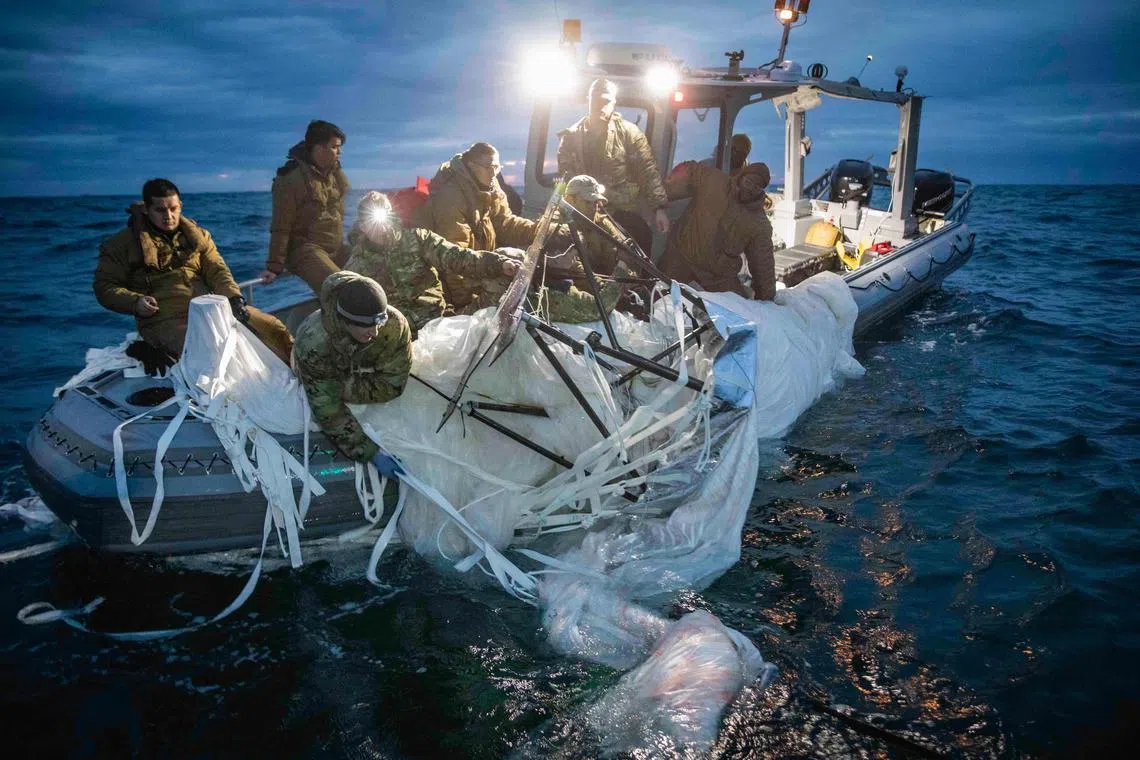What was the Chinese spy balloon trying to collect?
Sign up now: Get ST's newsletters delivered to your inbox

US Navy personnel recovering the Chinese balloon which had been shot down, off the coast of Myrtle Beach, South Carolina, on Feb 5.
PHOTO: AFP
Follow topic:
WASHINGTON – The United States government is combing through a variety of intelligence – debris, reconnaissance plane photos and old observations – to learn what the Chinese spy balloon was after as it made its way across the US in early February before being shot down by a Sidewinder missile
The Chinese spy balloon was equipped with an antenna meant to pinpoint the locations of communication devices and was capable of intercepting calls made on those devices, according to declassified intelligence released by the State Department on Thursday.
The balloon, which traversed America for several days,
In the wake of the discovery of the balloon, Secretary of State Antony Blinken cancelled a planned trip to Beijing.
China, perhaps in retaliation, rebuffed attempts by Defence Secretary Lloyd Austin to call his Chinese counterpart
Here is what we know about the balloon.
What was the spy balloon collecting?
This is the big question. Officials do not yet know what information the balloon was supposed to be stealing as it made its way across the country.
The balloon had a signals intelligence array – fancy spy speak for an antenna that can locate communication devices and listen in on them.
But officials do not yet know if that array was meant to gather calls made on military radios or from ordinary mobile phones, or something else altogether.
How many spy balloons have there been?
Balloons are hard to pick up on radar. Many of the first Chinese spy balloons that were observed near US military exercises or bases were not identified as surveillance tools.
Instead, they were classified as unidentified aerial phenomena, modern-day Pentagon jargon for unidentified flying objects.
Over the past 18 months, the US began learning more about the Chinese spy balloon programme.
As officials reviewed some previous cases of unidentified aerial phenomena, they determined that they were spy balloons.
A review of the old data showed that at least three spy balloons entered US airspace during the Trump administration.
There was at least one additional visit during the Biden administration.
But all of those previous incidents were relatively short – not the days-long transit of this month’s spy balloon.
Was this part of a wider Chinese surveillance programme?
China has developed a spy balloon programme as a complement to its fleet of reconnaissance satellites, American officials said, with a mission to collect information across the world.
Because the capabilities of the spy balloons are not yet perfectly understood, it is not certain if they gather different information from China’s satellites.
Nevertheless, officials said, at the very least, the balloons can linger longer over a site than a satellite.
And while reconnaissance satellites are often focused on imagery, the balloons appear to be mostly about collecting communications.
Some officials say the spy balloon programme has been focused on the Pacific region, collecting information on US bases and allied military operations.
And of course, the Chinese do not just use balloons to conduct surveillance at military bases. Some classified reports suggest they are also using advanced technologies to collect information about the US military.
Is this a big deal or not?
Yes. To be clear, the balloon saga is not comparable with an earthquake in Turkey that killed more than 20,000. Nor is it comparable with the war in Ukraine that is set to enter into a second year.
That said, the spy balloon incident will complicate the relationship between the two most powerful countries on earth.
Some policymakers and lawmakers in Washington have been arguing for years that the US public has not taken the challenge of China seriously enough – prioritising the country’s cheap mobile phones and entertaining videos on its TikTok platform over concerns about an authoritarian state that bolsters its power through the intrusive surveillance of its people.
But the balloon ordeal was a big enough deal for the State Department to cancel Secretary of State Antony Blinken’s planned trip – the first by a Biden Cabinet secretary to Beijing – without rescheduling it.
When he cancelled the trip, Mr Blinken said the entry of the balloon was a “clear violation of US sovereignty and international law.”
What is the plan for recovering debris?
Navy divers have been working to gather debris from the balloon
The balloon itself, as well as some wiring that was floating on the ocean surface, was quickly retrieved.
But most of the electronics were in the balloon’s payload, carried underneath.
The remains of that are scattered across the ocean floor, albeit in the relatively shallow waters off the South Carolina coast.
The dive teams are handing over the recovered material to the FBI ,
What state it will be in and how much can be learnt from it remain open questions.

FBI agents processing material recovered from the Chinese balloon.
PHOTO: NYTIMES
What happens next?
The Biden administration has continued to declassify and share information it has learnt about the spy balloon, bringing in allied and partner nations for briefings about China’s surveillance programmes.
The diplomatic push is a sign that the Biden administration intends to use the incident to rally its allies and convince them that China’s global ambitions could involve infringements of their own sovereignty.
Beijing was angry over the US decision to shoot down the balloon, which the Chinese Foreign Ministry described as “excessive”.
China has maintained that the balloon was a civilian device
Points of friction between Beijing and the US are becoming increasingly common.
China fired a barrage of missiles
Representative Kevin McCarthy said before succeeding her this year that he would also like to visit the self-governing island,

